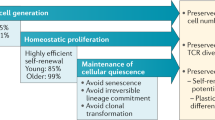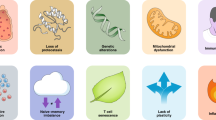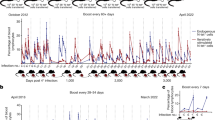Abstract
Evidence is accumulating that elderly individuals are more susceptible to infection with organisms to which they were previously immune. This indicates that there might be a limit to the persistence of immune memory. This fact is particularly disturbing because the average life expectancy of humans has almost doubled in the past 200 years and is still increasing. We discuss mechanisms that might constrain the persistence of memory T cells and consider whether humans will suffer from memory T-cell exhaustion as life expectancy increases.
This is a preview of subscription content, access via your institution
Access options
Subscribe to this journal
Receive 12 print issues and online access
$209.00 per year
only $17.42 per issue
Buy this article
- Purchase on Springer Link
- Instant access to full article PDF
Prices may be subject to local taxes which are calculated during checkout



Similar content being viewed by others
References
Lomborg, B. The Skeptical Environmentalist: Measuring the Real State of the World (Cambridge Univ. Press, 2001).
Keyfitz, N. & Flieger, W. World Population Growth and Aging Vol. 107 (Univ. Chicago Press, 1990).
Lutz, W., Sanderson, W. & Scherbov, S. Doubling of world population unlikely. Nature 387, 803–805 (1997).
Russell, J. C. in Fontana Economic History of Europe Vol. 1 (ed. Cipolla, C.) 25–70 (Fontana, London, 1978).
La Croix, A. Z., Lipson, S., Miles, T. P. & Whilte, L. Prospective study of pneumonia hospitalization and mortality of U.S. older people: the role of chronic conditions, health behaviours and nutritional status. Public Health Rep. 104, 350–360 (1989).
Gorse, G. J. et al. Bacterial meningitis in the elderly. Arch. Intern. Med. 144, 1603–1607 (1984).
Chattopadhyay, B. & Al Zahawi, M. Septicaemia and its unacceptably high mortality in the elderly. J. Infect. 7, 134–138 (1983).
Ackermann, R. J. & Monroe, P. W. Bacteremic urinary tract infection in older people. J. Am. Geriatr. Soc. 44, 927–933 (1996).
Barker, W. H. & Mullooly, J. P. Impact of epidemic type A influenza in a defined adult population. Am. J. Epidemiol. 112, 798–811 (1980).
Sprenger, M. J., Mulder, P. G., Beyer, W. E., Van Strik, R. & Masurel, N. Impact of influenza on mortality in relation to age and underlying disease, 1967–1989. Int. J. Epidemiol. 22, 334–340 (1993).
Yoshikawa, T. T. Perspective: aging and infectious diseases: past, present, and future. J. Infect. Dis. 176, 1053–1057 (1997).
Grubeck-Loebenstein, B. & Wick, G. The aging of the immune system. Adv. Immunol. 80, 243–284 (2002).
Berger, R., Florent, G. & Just, M. Decrease of the lymphoproliferative response to varicella-zoster virus antigen in the aged. Infect. Immun. 32, 24–27 (1981).
Scott, B. J., Powers, D. C., Johnson, J. E. & Morley, J. E. Seroepidemiologic evidence of Epstein–Barr virus re-activation in a veterans' nursing home. Serodiagn. Immunother. Infect. Dis. 6, 87–92 (1994).
Nagami, P. H. & Yoshikawa, T. T. Tuberculosis in the geriatric patient. J. Am. Geriatr. Soc. 31, 356–363 (1983).
Zhang, Y., Cosyns, M., Levin, M. J. & Hayward, A. R. Cytokine production in varicella zoster virus-stimulated limiting dilution lymphocyte cultures. Clin. Exp. Immunol. 98, 128–133 (1994).
Demkowicz, W. E. Jr, Littaua, R. A., Wang, J. & Ennis, F. A. Human cytotoxic T-cell memory: long-lived responses to vaccinia virus. J. Virol. 70, 2627–2631 (1996).
Hsieh, S. M., Pan, S. C., Chen, S. Y., Huang, P. F. & Chang, S. C. Age distribution for T cell reactivity to vaccinia virus in a healthy population. Clin. Infect. Dis. 38, 86–89 (2004).
Dworsky, R., Paganini-Hill, A., Arthur, M. & Parker, J. Immune responses of healthy humans 83–104 years of age. J. Natl Cancer Inst. 71, 265–268 (1983).
Linton, P. J. & Dorshkind, K. Age-related changes in lymphocyte development and function. Nature Immunol. 5, 133–139 (2004).
Olsson, J. & Wikby, A. Age-related change in peripheral blood T lymphocyte subpopulations and cytomegalovirus infection in the very old: the Swedish longitudinal OCTO immune study. Mech. Ageing Dev. 121, 187–201 (2000).
Ouyang, Q. et al. Age-associated accumulation of CMV-specific CD8+ T cells expressing the inhibitory killer cell lectin-like receptor G1 (KLRG1). Exp. Gerontol. 38, 911–920 (2003).
Ouyang, Q. et al. An age-related increase in the number of CD8+ T cells carrying receptors for an immunodominant Epstein–Barr virus (EBV) epitope is counteracted by a decreased frequency of their antigen-specific responsiveness. Mech. Ageing Dev. 124, 477–485 (2003).
Faint, J. M. et al. Memory T cells constitute a subset of the human CD8+CD45RA+ pool with distinct phenotypic and migratory characteristics. J. Immunol. 167, 212–220 (2001).
Sallusto, F., Geginat, J. & Lanzavecchia, A. Central memory and effector memory T cell subsets: function, generation, and maintenance. Annu. Rev. Immunol. 22, 745–763 (2004).
Weninger, W., Crowley, M. A., Manjunath, N. & von Andrian, U. H. Migratory properties of naive, effector, and memory CD8+ T cells. J. Exp. Med. 194, 953–966 (2001).
Hamann, D. et al. Phenotypic and functional separation of memory and effector human CD8+ T cells. J. Exp. Med. 186, 1407–1418 (1997).
Salmon, M. et al. The progressive differentiation of primed T cells is associated with an increasing susceptibility to apoptosis. Eur. J. Immunol. 24, 892–899 (1994).
Akbar, A. N., Salmon, M., Savill, J. & Janossy, G. A possible role for Bcl-2 in regulating T-cell memory — a 'balancing act' between cell death and survival. Immunol. Today 14, 526–532 (1993).
Pawelec, G. et al. T cells and aging, January 2002 update. Front. Biosci. 7, d1056–d1183 (2002).
Akbar, A. N., Terry, L., Timms, A., Beverley, P. C. & Janossy, G. Loss of CD45R and gain of UCHL1 reactivity is a feature of primed T cells. J. Immunol. 140, 2171–2178 (1988).
Geginat, J., Lanzavecchia, A. & Sallusto, F. Proliferation and differentiation potential of human CD8+ memory T-cell subsets in response to antigen or homeostatic cytokines. Blood 101, 4260–4266 (2003).
Dunne, P. J. et al. Epstein–Barr virus-specific CD8+ T cells that re-express CD45RA are apoptosis-resistant memory cells that retain replicative potential. Blood 100, 933–940 (2002).
Wills, M. R. et al. Human virus-specific CD8+ CTL clones revert from CD45ROhi to CD45RAhiin vivo: CD45RAhi CD8+ T cells comprise both naive and memory cells. J. Immunol. 162, 7080–7087 (1999).
Kuijpers, T. W. et al. Frequencies of circulating cytolytic, CD45RA+CD27−CD8+ T lymphocytes depend on infection with CMV. J. Immunol. 170, 4342–4348 (2003).
Khan, N. et al. Cytomegalovirus seropositivity drives the CD8 T cell repertoire toward greater clonality in healthy elderly individuals. J. Immunol. 169, 1984–1992 (2002).
Champagne, P. et al. Skewed maturation of memory HIV-specific CD8 T lymphocytes. Nature 410, 106–111 (2001).
Voehringer, D., Koschella, M. & Pircher, H. Lack of proliferative capacity of human effector and memory T cells expressing killer cell lectinlike receptor G1 (KLRG1). Blood 100, 3698–3702 (2002).
Hodes, R. J., Hathcock, K. S. & Weng, N. P. Telomeres in T and B cells. Nature Rev. Immunol. 2, 699–706 (2002).
Haynes, B. F., Markert, M. L., Sempowski, G. D., Patel, D. D. & Hale, L. P. The role of the thymus in immune reconstitution in aging, bone marrow transplantation, and HIV-1 infection. Annu. Rev. Immunol. 18, 529–560 (2000).
Jamieson, B. D. et al. Generation of functional thymocytes in the human adult. Immunity 10, 569–575 (1999).
Douek, D. C. et al. Changes in thymic function with age and during the treatment of HIV infection. Nature 396, 690–695 (1998).
Nagel, J. E., Chrest, F. J. & Adler, W. H. Enumeration of T lymphocyte subsets by monoclonal antibodies in young and aged humans. J. Immunol. 127, 2086–2088 (1981).
Wright, W. E. & Shay, J. W. Telomere dynamics in cancer progression and prevention: fundamental differences in human and mouse telomere biology. Nature Med. 6, 849–851 (2000).
Blackburn, E. H. Switching and signaling at the telomere. Cell 106, 661–673 (2001).
Ducray, C., Pommier, J. P., Martins, L., Boussin, F. D. & Sabatier, L. Telomere dynamics, end-to-end fusions and telomerase activation during the human fibroblast immortalization process. Oncogene 18, 4211–4223 (1999).
d'Adda, D. F. et al. A DNA damage checkpoint response in telomere-initiated senescence. Nature 426, 194–198 (2003).
Plunkett, F. J. et al. The flow cytometric analysis of telomere length in antigen-specific CD8+ T cells during acute Epstein–Barr virus infection. Blood 97, 700–707 (2001).
Reed, J. R. et al. Telomere erosion in memory T cells induced by telomerase inhibition at the site of antigenic challenge in vivo. J. Exp. Med. 199, 1433–1443 (2004).
Rufer, N. et al. Ex vivo characterization of human CD8+ T subsets with distinct replicative history and partial effector functions. Blood 102, 1779–1787 (2003).
Pawelec, G. et al. Is immunosenescence infectious? Trends Immunol. 25, 406–410 (2004).
Akbar, A. N., Soares, M. V., Plunkett, F. J. & Salmon, M. Differential regulation of CD8+ T cell senescence in mice and men. Mech. Ageing Dev. 121, 69–76 (2000).
Gupta, S., Kim, C., Yel, L. & Gollapudi, S. A role of Fas-associated death domain (FADD) in increased apoptosis in aged humans. J. Clin. Immunol. 24, 24–29 (2004).
Maini, M. K., Soares, M. V., Zilch, C. F., Akbar, A. N. & Beverley, P. C. Virus-induced CD8+ T cell clonal expansion is associated with telomerase up-regulation and telomere length preservation: a mechanism for rescue from replicative senescence. J. Immunol. 162, 4521–4526 (1999).
Hathcock, K. S., Kaech, S. M., Ahmed, R. & Hodes, R. J. Induction of telomerase activity and maintenance of telomere length in virus-specific effector and memory CD8+ T cells. J. Immunol. 170, 147–152 (2003).
Soares, M. V. et al. Integration of apoptosis and telomere erosion in virus-specific CD8+ T cells from blood and tonsils during primary infection. Blood 103, 162–167 (2004).
Sedgwick, R. P. & Boder, E. in Handbook of Clinical Neurology (ed. de Jong, J. M. J. V.) 347–423 (Elsevier Science, Amsterdam, 1991).
Dokal, I. Dyskeratosis congenita in all its forms. Br. J. Haematol. 110, 768–779 (2000).
Solder, B., Weiss, M., Jager, A. & Belohradsky, B. H. Dyskeratosis congenita: multisystemic disorder with special consideration of immunologic aspects. A review of the literature. Clin. Pediatr. (Phila.) 37, 521–530 (1998).
Blasco, M. A. et al. Telomere shortening and tumor formation by mouse cells lacking telomerase RNA. Cell 91, 25–34 (1997).
Lee, H. W. et al. Essential role of mouse telomerase in highly proliferative organs. Nature 392, 569–574 (1998).
Appay, V. et al. Memory CD8+ T cells vary in differentiation phenotype in different persistent virus infections. Nature Med. 8, 379–385 (2002).
Wikby, A. et al. Expansions of peripheral blood CD8 T lymphocyte subpopulations and an association with cytomegalovirus seropositivity in the elderly: the Swedish NONA immune study. Exp. Gerontol. 37, 445–453 (2002).
Davenport, M. P., Fazou, C., McMichael, A. J. & Callan, M. F. Clonal selection, clonal senescence, and clonal succession: the evolution of the T cell response to infection with a persistent virus. J. Immunol. 168, 3309–3317 (2002).
Wallace, D. L. et al. Direct measurement of T cell subset kinetics in vivo in elderly men and women. J. Immunol. 173, 1787–1794 (2004).
Rufer, N. et al. Transfer of the human telomerase reverse transcriptase (TERT) gene into T lymphocytes results in extension of replicative potential. Blood 98, 597–603 (2001).
Hooijberg, E. et al. Immortalization of human CD8+ T cell clones by ectopic expression of telomerase reverse transcriptase. J. Immunol. 165, 4239–4245 (2000).
Soares, M. V. et al. IL-7-dependent extrathymic expansion of CD45RA+ T cells enables preservation of a naive repertoire. J. Immunol. 161, 5909–5917 (1998).
Henson, S. M., Pido-Lopez, J. & Aspinall, R. Reversal of thymic atrophy. Exp. Gerontol. 39, 673–678 (2004).
Sharpless, N. E. & DePinho, R. A. Telomeres, stem cells, senescence, and cancer. J. Clin. Invest. 113, 160–168 (2004).
Crimmins, E. M. Mortality and health in human life spans. Exp. Gerontol. 36, 885–897 (2001).
Franceschi, C. et al. Long telomeres and well preserved proliferative vigor in cells from centenarians: a contribution to longevity? Aging (Milano) 11, 69–72 (1999).
Makinodan, T. Studies on the influence of age on immune response to understand the biology of immunosenescence. Exp. Gerontol. 33, 27–38 (1998).
Kipling, D. & Cooke, H. J. Hypervariable ultra-long telomeres in mice. Nature 347, 400–402 (1990).
Engwerda, C. R., Handwerger, B. S. & Fox, B. S. Aged T cells are hyporesponsive to costimulation mediated by CD28. J. Immunol. 152, 3740–3747 (1994).
Valenzuela, H. F. & Effros, R. B. Divergent telomerase and CD28 expression patterns in human CD4 and CD8 T cells following repeated encounters with the same antigenic stimulus. Clin. Immunol. 105, 117–125 (2002).
Maini, M. K., Gudgeon, N., Wedderburn, L. R., Rickinson, A. B. & Beverley, P. C. Clonal expansions in acute EBV infection are detectable in the CD8 and not the CD4 subset and persist with a variable CD45 phenotype. J. Immunol. 165, 5729–5737 (2000).
Hassan, J. & Reen, D. J. IL-7 promotes the survival and maturation but not differentiation of human post-thymic CD4+ T cells. Eur. J. Immunol. 28, 3057–3065 (1998).
White, A. & Cash, K. The State of Men's Health Across Seventeen European Countries (European Men's Health Forum, Brussels, 2003).
Acknowledgements
The authors would like to thank M. Vukmanovic-Stejic, R. Faragher, J. Fletcher and R. Aspinall for helpful discussions. This work was supported by grants from Research Into Ageing, London, United Kingdom, and The Biotechnology and Biological Sciences Research Council, United Kingdom.
Author information
Authors and Affiliations
Corresponding author
Ethics declarations
Competing interests
The authors declare no competing financial interests.
Rights and permissions
About this article
Cite this article
Akbar, A., Beverley, P. & Salmon, M. Will telomere erosion lead to a loss of T-cell memory?. Nat Rev Immunol 4, 737–743 (2004). https://doi.org/10.1038/nri1440
Issue Date:
DOI: https://doi.org/10.1038/nri1440
This article is cited by
-
T-cell lymphocytes’ aging clock: telomeres, telomerase and aging
Biogerontology (2024)
-
Regulation of telomerase towards tumor therapy
Cell & Bioscience (2023)
-
The effect of metformin on senescence of T lymphocytes
Immunity & Ageing (2023)
-
An intercellular transfer of telomeres rescues T cells from senescence and promotes long-term immunological memory
Nature Cell Biology (2022)
-
Rethinking peripheral T cell tolerance: checkpoints across a T cell’s journey
Nature Reviews Immunology (2021)



